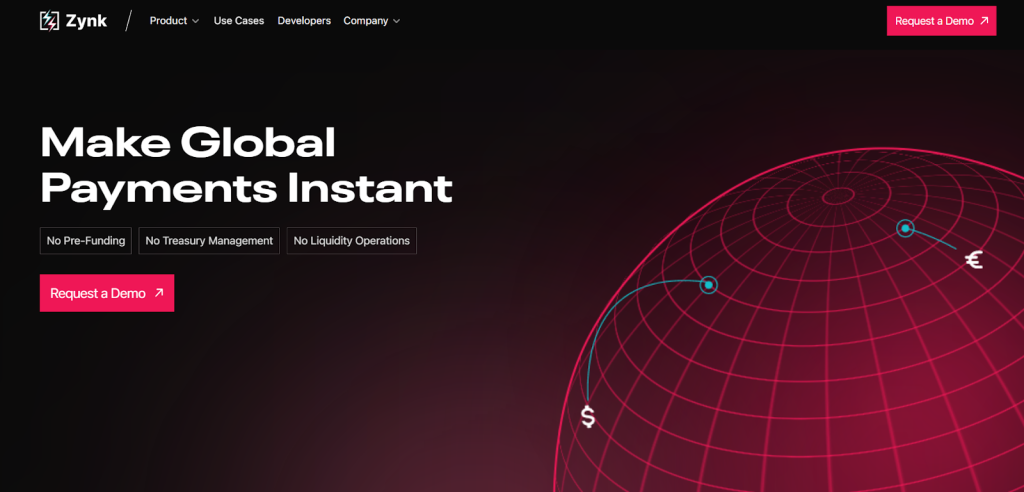Zynk Raises $5 Million Seed to Simplify Instant Cross-Border Payments
November 9, 2025
byFenoms Start-Up Research

Zynk - a fintech infrastructure startup enabling instant cross-border payments without needing pre-funded liquidity pools - has raised $5 million in seed funding. The round was led by Hivemind Capital and included participation from Alliance DAO, Coinbase Ventures, Transpose Platform VC, Polymorphic Capital, Tykhe Ventures, and Contribution Capital.
Headquartered in Hyderabad, India and founded by Prashanth Swaminathan, Zynk is redefining how payment providers, remittance services, and fintech developers move money globally by embedding just-in-time liquidity directly into its settlement infrastructure.
Turning Liquidity Operations Into a Competitive Advantage
Cross-border payments historically require local accounts, pre-funded balances, or complex banking relationships across multiple countries. Zynk’s solution removes much of that friction: its infrastructure supports settlement across multiple currencies (such as USD, EUR, INR, MXN, PHP, AED), enabling payments platforms to expand into new markets quickly without needing to hold large cash reserves locally.
By treating liquidity itself as a piece of infrastructure - moving capital only when transactions occur, instead of ahead of time - Zynk reduces waste, lowers compliance burden, and accelerates time-to-market for partners.
Why Zynk’s Approach Pushes the Fintech Frontier
Instant settlement used to be limited to large banks with global treasury networks. Zynk is democratizing access to real-time settlement by embedding liquidity logic within its own rails - making it easier for emerging payment platforms to operate globally from day one.
That’s powerful because it shifts the model: from building your own local banking relationships to accessing liquidity-as-a-service via code. It’s fintech infrastructure that feels more API than bank. And with its seed funding in hand, Zynk is positioned to scale its corridor coverage, enhance its compliance stack, and secure partnerships with regulators and payment providers around the world.
How Founders Can Think About Liquidity as a Product
In the heart of Zynk’s tech lies a founder lesson that applies far beyond payments: treat operational friction as your moat, not just your feature gap.
Many early-stage fintechs obsess over user onboarding flows, UI polish, or front-end speed - and those absolutely matter. But what if instead, you built your startup around the invisible cost customers bear behind the scenes? For Zynk, that cost is liquidity: the cash tied up in bank accounts, the manual processes for moving money, the delays built into settlement windows.
By reimagining liquidity itself as something you programmatically optimize and remove, Zynk didn’t just improve performance - it eliminated an entire structural drag on growth. That’s more than “feature innovation.” It’s redefining how money flows.
Founders, especially in fintech or infrastructure-heavy verticals, should ask themselves: what opaque cost are my customers enduring that I can redesign as a product? Eliminate that cost at the protocol level, and you don’t just compete - you unlock capacity they never thought to free.
That mindset doesn’t land in your UI wireframes. It lives in your data schema, your risk-control flows, your compliance logic, and your latency assumptions. It becomes the reason why your product scales more efficiently than you could ever explain through design screens.
The Market and Momentum Behind Zynk
Zynk launched quietly in April 2025 and is already seeing rapid early traction, including claims of 70% month-over-month growth in its corridors of operations.
Its investors - including Hivemind Capital and Coinbase Ventures - are backing not just the promise of faster payments, but also the architecture that allows partners to scale internationally without banking overhead.
That level of investor confidence is rare for early-stage fintechs, especially those trying to tackle deeply regulated or liquidity-intensive backends. It suggests that Zynk’s positioning is not just timely - it might be foundational to the next generation of global payment rails.
Challenges & What’s Next for Zynk
Even with strong backing, Zynk faces significant scaling challenges: regulatory compliance in multiple jurisdictions, real-time liquidity risk management, FX exposure, and building relationships with banks or correspondent providers.
Yet its core promise gives it leverage: by keeping liquidity dynamic and programmable, Zynk can adapt corridor-by-corridor without rebuilding its architecture. The rounds of investment will support engineering expansion, compliance certification, and deeper integration with payment partners and platforms.
For founders watching this space, Zynk provides a valuable reminder: when you build protocol-level infrastructure instead of UI-level features, your scaling problems shift - but so does your opportunity.
Zynk’s Long-Term Vision
Over time, Zynk could evolve from a settlement engine into a full-stack embedded payments infrastructure partner for fintechs, remittance operators, and cross-border platforms - offering settlement, compliance tooling, risk management, and routed liquidity all via API.
If it executes well, its technology could become a recurring part of how money moves globally, not just a startup feature. That would shift its business model from being a payments enabler to becoming plumbing that almost every emerging financial product depends on.
For now, with $5 million in seed funding, the company has the runway to refine its product, expand its corridors, and continue proving that liquidity doesn’t need to be an expensive constraint - it can be a lean, programmable asset.









